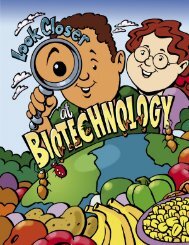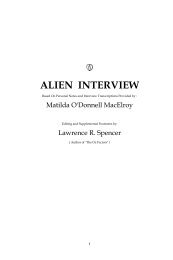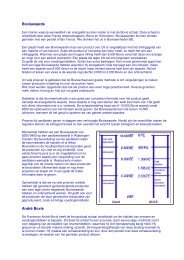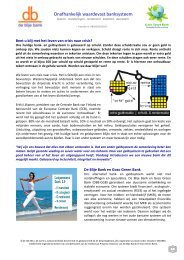De verborgen gevaren van vaccinaties - WantToKnow.nl
De verborgen gevaren van vaccinaties - WantToKnow.nl
De verborgen gevaren van vaccinaties - WantToKnow.nl
Create successful ePaper yourself
Turn your PDF publications into a flip-book with our unique Google optimized e-Paper software.
kunnen daarna ook als overerfbare genetische aandoeningen overgedragen worden aan het<br />
nageslacht en zich – via genetische drift – verspreiden onder de hele populatie.<br />
Hoe dat werkt volgt – samen met evidentie voor dit mechanisme - hieronder.<br />
Op 27-4-2009 vond ik in mijn maibox een stuk informatie onder de noemer Updates on the<br />
International Biological Situation (Mon April 20, 2009). Het handelde over de ontwikkeling<br />
<strong>van</strong> nieuwe soorten vaccins. Mijn oog viel direct op de volgende alinea:<br />
[…] AVI BioPharma has apparently received FDA approval for new RNA-altered “antisense”<br />
(aptly named for sure) vaccines for Ebola and Marlburg viruses. In 2005-2006 they<br />
led the way in researching “bird-flu” vaccines, but now they are leading the way in other<br />
virulent killer virus research. See http://www.avibio.com/biodefense-program.php. and<br />
http://www.avibio.com/rna-therapeutics.php. [...]<br />
Ik opende meteen het laatste <strong>van</strong> de twee genoemde bestanden en de inhoud daar<strong>van</strong> was zo<br />
interessant dat ik die hieronder in zijn geheel laat volgen:<br />
[…] How RNA Therapeutics Work<br />
Using modern methods of chemical synthesis, AVI makes compounds that bind selectively to<br />
RNA, the carrier of genetic information from DNA to protein, and prevent production of a<br />
particular protein. If this protein is needed for a virus infection or causes a disease, e.g.<br />
cancer, the disease may be prevented or treated. AVI BioPharma is an early pioneer of<br />
antisense technology, the precursor of the growing field of RNA therapeutics.<br />
RNA-based therapeutic compounds are made up of subunits or monomers, linked together<br />
and called oligomers. Each subunit carries a genetic “letter” or base (A, T, G or C) that<br />
allows it to pair with its complementary monomer on the RNA target (A pairs with T and G<br />
with C). The order of sequence of these “letters” determines the identity of the RNA to which<br />
it binds, as well as the precise position in the sequence of the RNA that it seeks out<br />
specifically. When the target is mRNA, which translates genetic information in protein, AVI<br />
compounds are called Translation Suppressing Oligomers or TSO’s. AVI oligomers can also<br />
be targeted to a pre-mRNA, which is not yet mature and needs to be processed and spliced to<br />
make mRNA. Used in this capacity, AVI compounds are called Splice Switching Oligomers or<br />
SSO’s because they can determine which – of several choices – mRNA is actually made<br />
preferentially.<br />
Genetic letters and base pairing are common to all RNA therapeutics, but chemists can<br />
change the chemical character of the therapeutics molecules in subtle but significant ways.<br />
For example, the fine structure and charge of the monomers determines the strenght of the<br />
linkages that hold them to their target, the “backbone”of the oligomers can be altered to<br />
achieve different properties, such as resistance to enzymic degradation or bioavailability.<br />
The older antisense compound, and also siRNA, are designed to degrade their target RNA<br />
molecules. Instead, AVI oligomers with morpholino backbone act by “steric blocking” –<br />
binding to a target sequence within the RNA molecule and simply obstructing other<br />
molecules that might otherwise interact with the RNA. Thus, there is no degadation of the<br />
drug or its target mRNA […]<br />
Hier staat dus beschreven wat ik eerder ook al betoogde over de uitwerking <strong>van</strong> het elektronegatieve<br />
aluminium. Door de ‘lading’ <strong>van</strong> dit elektro-actieve element wordt de onderlinge<br />
binding <strong>van</strong> atomen geregeld en daarmee ook de vouwing – ofwel de ruimtelijke structuur –<br />
132







